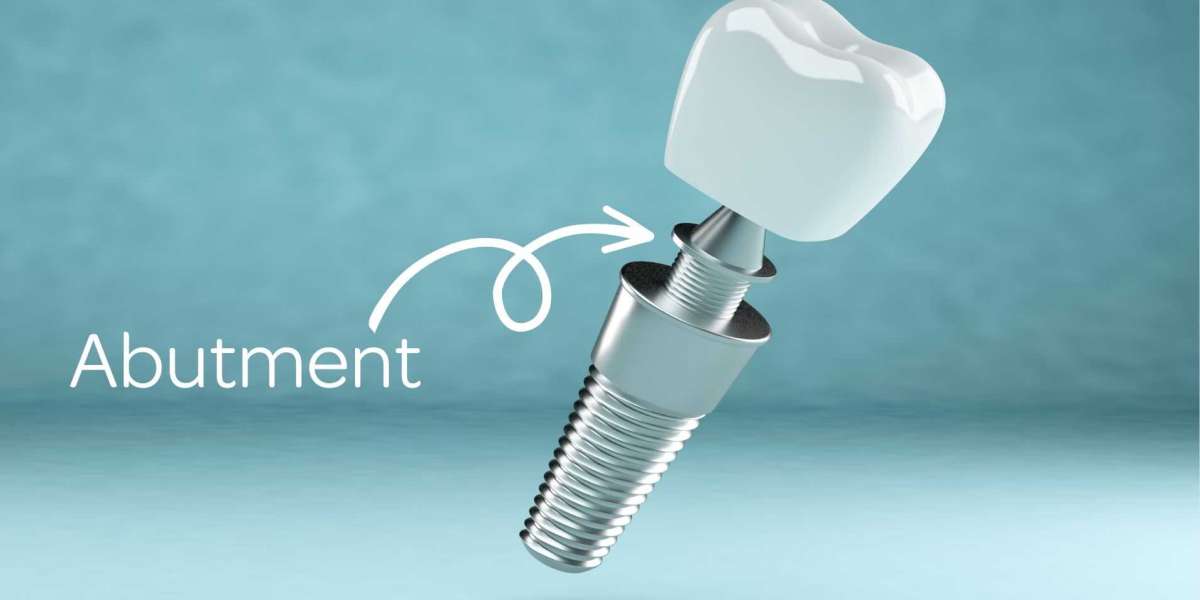When you start searching for dental implants near me, the first things that come to mind are likely the implant post and the crown—the visible components that make up the dental implant. However, there’s one part of the implant system that is often overlooked but plays a crucial role in the success of the entire procedure: the abutment. While it might be small and often out of sight, the abutment has a huge impact on how your smile will look, feel, and function in the long run. In this blog, we’ll go beyond the basics to explore how dental implant abutments influence your smile and why they should never be underestimated.
What is a Dental Implant Abutment?
To understand the significance of the abutment, it’s essential to know exactly what it is and what it does. A dental implant abutment is a connector piece that sits between the implant post (the metal screw that is placed into the jawbone) and the crown (the visible replacement tooth). It’s essentially the “bridge” that allows the crown to be securely attached to the implant post, making it a vital part of the dental implant system.
Once the implant post has been placed and has successfully integrated into the jawbone through a process called osseointegration, the abutment is placed on top of the post. The abutment is then used as the foundation for securing the crown or other restoration, like a bridge or denture, to the implant post. In short, it connects the prosthetic tooth to the implant, allowing you to eat, speak, and smile naturally once again.
The Role of Abutments in the Aesthetic Outcome of Your Smile
The aesthetic impact of a dental implant is a major reason many patients choose this restoration option. One of the primary ways that abutments influence the overall look of your smile is by determining the positioning and alignment of the crown.
1. Creating a Natural Appearance
For dental implants to blend seamlessly with your natural teeth, the abutment must be carefully chosen and positioned. Abutments come in various shapes, sizes, and angles, and the right one must be selected based on the patient’s unique anatomy and the location of the missing tooth.
In particular, for patients who are replacing front teeth, the abutment plays a significant role in ensuring that the final crown aligns with the natural tooth structure and gum line. A custom-made abutment allows for more precise placement, ensuring that the crown looks and feels like a natural tooth. If the abutment doesn’t fit properly or is misaligned, the crown may appear too bulky, off-center, or out of place in the smile, negatively affecting the overall aesthetics.
2. Enhancing Gum Contours
A well-fitted abutment also supports the natural contours of the gums around the implant. This is especially important for patients with missing front teeth, where the appearance of the gum line is just as important as the tooth itself. Abutments designed for optimal gum integration help ensure that the gums around the implant heal properly and that the prosthetic tooth blends smoothly with the gum tissue, creating a more natural and aesthetically pleasing result.
3. Customization for Unique Needs
Not all smiles are the same, and not all dental implant cases are straightforward. When you visit a dental professional to inquire about "dental implants near me," be sure to ask about custom abutments. For patients with unique needs—such as those who have irregular bone structures or limited space in the mouth—a custom abutment can be fabricated to fit their specific anatomy, resulting in a more accurate and aesthetically pleasing outcome. The customization of abutments allows the final restoration to be tailored to each individual’s smile.
How Abutments Contribute to the Functionality of Your Smile
While the appearance of your smile is undeniably important, the functionality of your implant is just as critical. After all, a dental implant is not only meant to improve aesthetics but also to restore the full function of your teeth.
1. Ensuring Stability
Abutments play a critical role in ensuring that the implant post remains stable and that the crown is securely attached to it. When an abutment is properly placed, it ensures that the entire implant system can withstand the forces of biting and chewing. A strong and well-designed abutment prevents the crown from becoming loose or shifting over time, providing long-term stability for the restoration.
Additionally, abutments help in distributing the forces of biting and chewing evenly across the implant post. Without an abutment, the forces generated by chewing could be focused on one spot, which could lead to complications such as implant failure or damage to the surrounding teeth.
2. Supporting Your Bite
An abutment that is properly aligned also ensures that your bite remains intact. If the abutment is misaligned or improperly fitted, it can cause an uneven bite, leading to discomfort, jaw strain, or even misalignment of the surrounding teeth. This is especially crucial for patients with implants in the back of the mouth, where the forces of chewing are more intense. The abutment’s role in keeping the crown properly positioned helps to maintain a balanced and functional bite, making sure your new smile works just as well as it looks.
3. Customizing for Bite and Function
Not only do abutments help with aesthetics, but they also allow for customization based on the patient’s unique bite and jaw alignment. Some patients may require angled abutments to ensure that the implant and crown align properly with the rest of their teeth. This is especially important when implants are placed in challenging areas, such as when there is limited space in the jaw or the implant needs to be placed at a specific angle.
With customized abutments, patients can enjoy the benefits of both functional and aesthetic restoration, allowing them to eat, speak, and smile with ease.
The Importance of High-Quality Abutments
When considering dental implants, it’s crucial to recognize the importance of using high-quality abutments. Poorly made or improperly fitted abutments can result in a host of complications, from discomfort to implant failure. On the other hand, high-quality abutments are precision-engineered to fit the implant post and the patient’s unique anatomy. These abutments help reduce the risk of complications and ensure the long-term success of the implant.
Additionally, using the right materials for the abutment can impact both the function and appearance of your implant. While titanium is a common material due to its strength and biocompatibility, some patients may require zirconia abutments for a more natural look, especially in the front of the mouth. A skilled dentist will carefully consider the best material and type of abutment to ensure optimal results.
Conclusion
Dental implant abutments may be small components in the implant system, but they have a profound impact on both the functionality and aesthetics of your smile. From ensuring the stability and alignment of the implant to enhancing the overall appearance of the restoration, the abutment is integral to the success of the procedure. Whether you need a stock, custom, or angled abutment, it’s essential to work with a dentist who understands the importance of this crucial part of the implant system.
If you’re considering dental implants, don’t forget to ask your dentist about the abutment options available to you. By choosing the right abutment, you can enjoy a stable, functional, and aesthetically pleasing smile that looks and feels just like your natural teeth. To start your journey toward a new smile, search for "dental implants near me" and schedule a consultation with a trusted implant specialist who can guide you through the process and ensure the best possible outcome.








